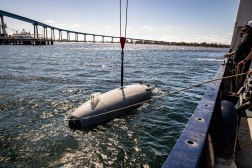DOD to ‘complement’ Replicator initiative by accelerating solid rocket motor production

The Pentagon on Tuesday released its implementation plan for the National Defense Industrial Strategy, which calls for boosting production of solid rocket motors as a “complement” to its Replicator unmanned systems initiative.
A key goal of Replicator is to help grease the wheels of the acquisition system so that the department can field thousands of “attritable autonomous” platforms to counter China’s military buildup in the Indo-Pacific. As DefenseScoop has previously reported, the initial tranches include loitering munitions and other types of drones, uncrewed surface vessels and unmanned underwater vehicles. Last month, the department unveiled Replicator 2.0, which is largely focused on accelerating the fielding of counter-drone capabilities.
“To complement the Replicator Initiative, the Department intends to commission various projects, studies, and white paper reviews to identify vendors who can accelerate solid rocket motor production,” the implementation plan for the Pentagon’s first-ever National Defense Industrial Strategy stated.
Solid rocket motors (SRM) — which are critical for munitions, boosters for satellite launchers and other items — fall under the category of “kinetic capabilities” that the DOD is focusing on.
The implementation plan noted that the department will evaluate proposals from the Defense Industrial Base Consortium (DIBC), which uses other transaction authority.
“There is already ongoing work within the department on addressing what have been previously identified five key areas of industrial capability where we need to put forward significant effort. And kinetic capabilities … have been one of those focus areas. So with regard to solid rocket motors, there is going to be a complementary effort, but separate from, if you will, to the Replicator effort, which … is a specific endeavor that is going to produce, you know, affordable and in these initial instances, attritable systems, right, for [us] to execute our strategy, specifically in the Indo-Pacific. But there are going to be a need for complementary technologies that are going to enable some of these efforts. So that is the point of talking about SRM and associated kinetic capabilities,” Carla Zeppieri, deputy assistant secretary of defense for industrial base resilience, told DefenseScoop during a briefing with reporters Tuesday to roll out the new implementation plan.
The document noted that Defense Production Act Title III initiatives — which aim to expand manufacturing capacity and supplies of critical technologies — in support of the DIBC and Joint Energetics Transition Office are eyeing multiple awards of $5 million to $75 million over the next five years.
“If DPA Title III does not receive the funding required to support DIBC and the JETO, their efforts to strengthen the SRM industrial base could face significant challenges and potentially not be executed,” officials warned in the implementation plan.
Zeppieri said the plan — which will also include a classified annex that is slated to be delivered before the end of the year — lays out where officials expect resources to come from to support the various initiatives highlighted in the broader strategy.
“In some cases, they’re coming from within, you know, already funded programs. And some cases looking forward, you know, they will need to be topics … of future budget requests. But with regard to DPA, there is, you know, an active appropriations bill right now … in the Congress that we are working with the appropriators for a successful final outcome that is going to fund all of those priority projects that are in the pipeline to be addressed,” she told DefenseScoop.
Officials have also been putting together the fiscal 2026 budget request and five-year spending projections for the future years defense program, which are expected to be released next year.
During the briefing, officials were asked whether a lack of funding for Defense Production Act or DIBC other transaction efforts for solid rocket motors in the near term would slow down the Replicator initiative.
“I don’t believe that would happen,” Laura Taylor-Kale, assistant secretary of defense for industrial base policy, told reporters.
In a problem statement accompanying a request for white papers issued by the DIBC a few months ago, officials noted some of the shortfalls that the Pentagon is facing.
“The SRM manufacturing capacity is constrained and fragile due to current geopolitical events. The United States Defense Industrial Base (DIB) currently does not have enough manufacturing capacity of SRMs to support ongoing engagements in the Middle East, Ukraine, and preparations in the Pacific, nor enough to quickly replenish domestic stockpiles,” the document stated.
To get after that problem, the Manufacturing Capability Expansion and Investment Prioritization (MCEIP) office is seeking additional SRM and SRM component and sub-component suppliers to create a more resilient industrial base, increase domestic capacity, encourage industry competition and reduce unit costs.
Proposers were told that they must demonstrate the technical and manufacturing feasibility of establishing one or more domestic, commercially viable prototype production lines capable of producing solid rocket motors, components or sub-components.
The document said multiple awards are anticipated with individual project agreement funding estimated between $5 million and $75 million over the next five years, subject to future availability of government funding.






